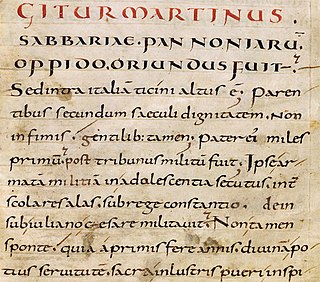 W
WA hagiography is a biography of a saint or an ecclesiastical leader, and by extension, an adulatory and idealized biography of a founder, saint, monk, nun or icon in any of the world's religions.
 W
WSaint Adamo Abate was an Italian medieval Benedictine abbot, a promoter of the unification of the Southern populations in Italy under Roger II of Sicily.
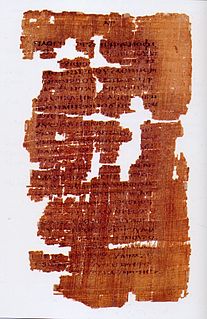 W
WThe Abgar legend, according to Christian tradition, posits an alleged correspondence and exchange of letters between Jesus Christ and King Abgar V Ukkāmā of Osroene. In the fourth century Eusebius of Caesarea published two letters which were allegedly discovered in the archives of Edessa. They claim to be an exchange of correspondence between Jesus Christ and King Abgar V which were written during the last years of Jesus' life.
 W
WDasius of Durostorum is a Christian martyr of the early 4th century AD. He was a Roman soldier of Legio XI Claudiana at Durostorum, Moesia Inferior who was beheaded in the early 4th century after his refusal to take the part of "king" in the local Saturnalia celebrations.
 W
WActa Sanctorum is an encyclopedic text in 68 folio volumes of documents examining the lives of Christian saints, in essence a critical hagiography, which is organised according to each saint's feast day. The project was conceived and begun by Jesuit Heribert Rosweyde. After his death in 1629, the Jesuit scholar Jean Bolland continued the work, which was gradually finished over the centuries by the Bollandists, who continue to edit and publish the Acta Sanctorum.
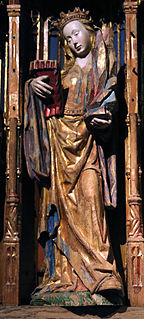 W
WSaint Sunniva is the patron saint of the Norwegian Diocese of Bjørgvin, as well as all of Western Norway.
 W
WActs of the Martyrs are accounts of the suffering and death of a Christian martyr or group of martyrs. These accounts were collected and used in church liturgies from early times, as attested by Saint Augustine.
 W
WThe Acts of Thaddeus is a Greek document written between 544 and 944 CE which purports to describe correspondence between King Abgar V of Edessa and Jesus, which results in Jesus' disciple Thaddeus going to Edessa.
 W
WThe Doctrine of Addai is a Syriac Christian text, written in the late 4th or early 5th century CE, recites the Legend of the Image of Edessa as well as the legendary works of Addai and his disciple Mari in Mesopotamia.
 W
WAgape, Chionia and Irene were sisters and Christian saints from Aquileia, martyred at Thessalonica in 304 AD. Agape and Chionia were charged with refusing to eat sacrificial offerings, whilst Irene was killed for keeping Christian books in violation of existing law. All were condemned to be burned alive.
 W
WThe Annolied is an Early Middle High German poem in praise of Archbishop Anno II of Cologne. Anno died in 1075 and the poem, probably written in the years immediately after his death, can be seen as part of a campaign for his canonisation, which was finally achieved in 1183.
 W
WBeunans Meriasek is a Cornish play completed in 1504. Its subject is the legends of the life of Saint Meriasek or Meriadoc, patron saint of Camborne, whose veneration was popular in Cornwall, Brittany, and elsewhere. It was written in the Cornish language, probably written around the same time and in the same place as Bewnans Ke, the only other extant Cornish play taking a saint's life as its subject.
 W
WBewnans Ke is a Middle Cornish play on the life of Saint Kea or Ke, who was venerated in Cornwall, Brittany and elsewhere. It was written around 1500 but survives only in an incomplete manuscript from the second half of the 16th century. The play was entirely unknown until 2000, when it was identified among the private collection of J. E. Caerwyn Williams, which had been donated to the National Library of Wales after his death the previous year. The discovery proved one of the most significant finds in the study of Cornish literature and language.
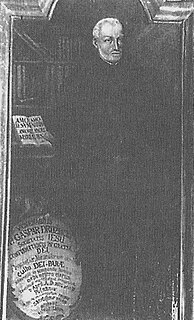 W
WKasper Drużbicki or Gaspar Druzbicius was a Polish Jesuit and ascetic writer.
 W
WEadfrith of Leominster also known as Eadridus was a seventh century Catholic saint from Anglo-Saxon England. Although very little is known of his early life, he is an important figure in the process of Christianisation of Anglo-Saxon England.
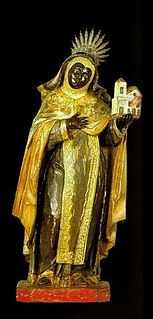 W
WSaint Ephigenia of Ethiopia or Iphigenia of Ethiopia, also called Iphigenia of Abyssinia, is a folk saint whose life is told in the Golden Legend as a virgin converted to Christianity and then consecrated to God by St. Matthew the Apostle, who was spreading the Gospel to the region of "Ethiopia," which in this case is understood to be located in the regions south of the Caspian Sea, either in one of the provinces of Mesopotamia, or in Ancient Armenia (Colchis).
 W
WThe Golden Legend is a collection of hagiographies by Jacobus de Varagine that was widely read in late medieval Europe. More than a thousand manuscripts of the text have survived. It was likely compiled around the years 1259–1266, although the text was added to over the centuries.
 W
WSaint Leoluca, also Leone Luca, Leo Luke of Corleone, or Luke of Sicily was the Abbot and Wonderworker of the Monastery of Mount Mula in Calabria, and a founder of Italo-Greek monasticism in southern Italy. He is venerated as a saint in the Roman Catholic and Eastern Orthodox churches.
 W
WBibliothèque Nationale, MS fr. 2090-2092 is an illuminated manuscript of The Life of Saint Denis, a hagiographical account of the life and martyrdom of Saint Denis, the first Bishop of Paris. The manuscript was produced in Paris and was begun at the request of John de Pontoise, Abbot of the Abbey of Saint Denis during the reign of Philip IV. The manuscript was completed in 1317 and presented by the abbot to Philip V.
 W
WThe Life of St. Sava was the second biography of Saint Sava (1169–1236), the first Archbishop of Serbs, written by Serbian monk Teodosije the Hilandarian (1246–1328), after the first biography written in 1254 by monk Domentijan.
 W
WThe Lives of the Saints from the Old and New Testaments is a hagiography by Polish Jesuit Piotr Skarga. It became one of the most popular Polish books ever and a classic of Polish literature. It is one of two most famous works by Skarga, the other being Sejm Sermons.
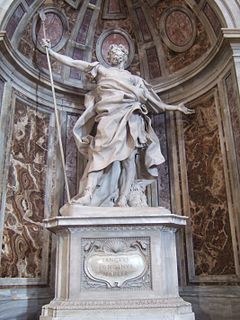 W
WLonginus is the name given to the unnamed Roman soldier who pierced the side of Jesus with a lance and who in medieval and some modern Christian traditions is described as a convert to Christianity. His name first appeared in the apocryphal Gospel of Nicodemus. The lance is called in Christianity the "Holy Lance" (lancea) and the story is related in the Gospel of John during the Crucifixion. This act is said to have created the last of the Five Holy Wounds of Christ.
 W
WSaint Mari, also known as Mares and originally named Palut, is a saint of the Church of the East. He was converted by Thaddeus of Edessa, or Addai, and is said to have had Mar Aggai as his spiritual director. He is believed to have done missionary work around Nineveh, Nisibis, and along the Euphrates, and is said to have been one of the great apostles to Syria and Persia. He was buried in Dair-Kuni. His feast day is 5 August in the Christian calendar. He and Thaddeus are credited with the Liturgy of Addai and Mari. Despite the fact that there is little, if any, concrete information on Mari, he is still venerated as a saint by the Assyrian Church of the East, the Chaldean Catholic Church, and the Syro-Malabar Catholic Church. He is identified as St. Mari of the seventy disciples with whom the Apocryphal Acts of Mar Mari are connected.
 W
WThe Martyrologium Hieronymianum or Martyrologium sancti Hieronymi is an ancient martyrology or list of Christian martyrs in calendar order, one of the most used and influential of the Middle Ages. It is the oldest surviving general or "universal" martyrology, and the precursor of all later Western martyrologies.
 W
WThe Martyrology of Tallaght, which is closely related to the Félire Óengusso or Martyrology of Óengus the Culdee, is an eighth- or ninth-century martyrology, a list of saints and their feast days assembled by Máel Ruain and/or Óengus the Culdee at Tallaght Monastery, near Dublin. The Martyrology of Tallaght is in prose and contains two sections for each day of the year, one general and one for Irish saints. It also has a prologue and an epilogue.
 W
WThe Martyrology of Usuard is a work by Usuard, a monk of the Benedictine Abbey of Saint-Germain-des-Prés. The prologue is dedicated to Charles the Bald indicating that it was undertaken at that monarch's instigation. It was apparently written shortly before the author's death in 877.
 W
WMartyr's Mirror or The Bloody Theater, first published in Holland in 1660 in Dutch by Thieleman J. van Braght, documents the stories and testimonies of Christian martyrs, especially Anabaptists. The full title of the book is The Bloody Theater or Martyrs Mirror of the Defenseless Christians who baptized only upon confession of faith, and who suffered and died for the testimony of Jesus, their Saviour, from the time of Christ to the year A.D. 1660. The use of the word defenseless in this case refers to the Anabaptist belief in non-resistance. The book includes accounts of the martyrdom of the apostles and the stories of martyrs from previous centuries with beliefs similar to the Anabaptists.
 W
WThe Menologion of Basil II is an illuminated manuscript designed as a church calendar or Eastern Orthodox Church service book (menologion) that was compiled c. 1000 AD, for the Byzantine Emperor Basil II. It contains a synaxarion, a short collection of saints' lives, compiled at Constantinople for liturgical use, and around 430 miniature paintings by eight different artists. It was unusual for a menologion from that era to be so richly painted. It currently resides in the Vatican Library . A full facsimile was produced in 1907.
 W
WA miracle of the roses is a miracle in which roses manifest an activity of God or of a saint. Such a miracle is presented in various hagiographies and legends in different forms, and it occurs in connection with diverse individuals such as Saints Elizabeth of Hungary (1207–1231), Elizabeth of Portugal (1271–1336), St. Dorothy, a 4th-century virgin martyr at Caesarea in Cappadocia, and Our Lady of Guadalupe.
 W
WPassio Olavi, more correctly Passio a miracule beati Olavi is a collection of legends about the Norwegian national saint Olaf II the Holy. The text was probably collected while Eysteinn Erlendsson was Archbishop of Nidaros (1159-1188), and is possibly written by Eysteinn himself. Egil Kraggerud dated the Passio Olavi to ca. 1150-1160.
 W
WPatericon or paterikon, a short form for πατερικόν βιβλίον, is a genre of Byzantine literature of religious character, which were collections of sayings of saints, martyrs and hierarchs, and tales about them. These texts also have their roots in early monasticism.
 W
WDaniel Pawłowski was a Polish Jesuit, theological writer.
 W
WSaint Philomena was a young consecrated virgin whose remains were discovered on May 24–25, 1802, in the Catacomb of Priscilla. Three tiles enclosing the tomb bore an inscription, Pax Tecum Filumena, that was taken to indicate that her name was Filumena, the English form of which is Philomena. Philomena is the patron saint of infants, babies, and youth.
 W
WPontius, or Pontius the Deacon, was a Christian saint and Latin author from Carthage. He served as a deacon under Cyprian of Carthage and wrote the Vita Cypriani shortly after Cyprian's death.
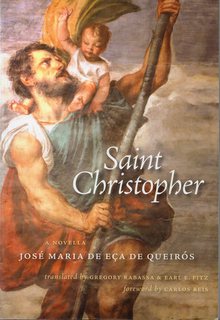 W
WSaint Christopher is a novella by José Maria de Eça de Queirós, also known as Eça de Queiroz, that draws on the legend of Saint Christopher. Written in the 1890s, it was first published posthumously in Portuguese in 1912. The first English version, translated by Gregory Rabassa and Earl E. Fritz, was published by Tagus Press in 2015.
 W
WThe Sequence of Saint Eulalia, also known as the Canticle of Saint Eulalia is the earliest surviving piece of French hagiography and one of the earliest extant texts in the vernacular langues d'oïl. It dates from around 880.
 W
WStephaton, or Steven, is the name given in medieval Christian traditions to the Roman soldier or bystander, unnamed in the Bible, who offered Jesus a sponge soaked in vinegar wine at the Crucifixion. In later depictions of the Crucifixion, Stephaton is frequently portrayed with Longinus, the name given to the soldier who pierced Jesus' side with a spear.
 W
WThe Synaxarion of Constantinople is a Greek collection of brief notices of saints commemorated in the churches of Constantinople arranged by feast. Each notice contains a short biography and the date and location of the commemoration (synaxis). It also contains descriptions of liturgical processions in the city. It was commissioned by the Emperor Constantine VII during his sole reign (944–959) and compiled by the deacon and librarian Evaristos. It is an important source for the urban topography of Constantinople.
 W
WSynaxarion or Synexarion is the name given in the Eastern Orthodox, Oriental Orthodox and Eastern Catholic Churches to a compilation of hagiographies corresponding roughly to the martyrology of the Roman Church.
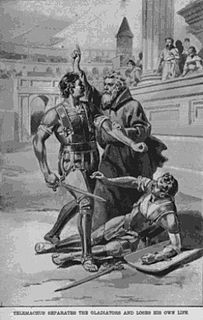 W
WSaint Telemachus was a monk who, according to the Church historian Theodoret, tried to stop a gladiatorial fight in a Roman amphitheatre, and was stoned to death by the crowd. The Christian Emperor Honorius, however, was impressed by the monk's martyrdom and it spurred him to issue a historic ban on gladiatorial fights. Frederick George Holweck gives the year of his death as 391. The last known gladiatorial fight in Rome was on 1 January 404 AD.
 W
WAccording to Eastern Christian tradition, Thaddeus of Edessa was one of the seventy disciples of Jesus. He is possibly identical with Thaddaeus, one of the Twelve Apostles. From an early date his hagiography is filled with legends and fabrications. The saint himself may be entirely fictitious.
 W
WThe Tale of Peter and Fevronia of Murom is a 16th-century Russian tale by Hermolaus-Erasmus, often referred to as a hagiography.
 W
WCodex Climaci rescriptus is a collective palimpsest manuscript consisting of several individual manuscripts (eleven) underneath with Christian Palestinian Aramaic texts of the Old and New Testament as well as two apocryphal texts, including the Dormition of the Mother of God, and is known as Uncial 0250 with a Greek uncial text of the New Testament and overwritten by Syriac treatises of Johannes Climacus : the scala paradisi and the liber ad pastorem. Paleographically the Greek text has been assigned to the 7th or 8th century, and the Aramaic text to the 6th century. It originates from Saint Catherine’s Monastery going by the News Finds of 1975. Formerly it was classified as lectionary manuscript, with Gregory giving the number ℓ 1561 to it.
 W
WThe Vita Annonis Minor is a hagiography of Saint Anno, No. 509 in the Bibliotheca Hagiographica Latina (BHL). The only extant mediaeval manuscript is in the Universitäts- und Landesbibliothek Darmstadt under reference Hs. 945.
 W
WThe Vita Germani is a hagiographic text written by Constantius of Lyon in the 5th century AD. It is one of the first hagiographic texts written in Western Europe, and is an important resource for historians studying the origins of saintly veneration and the "cult of saints." It recounts the life and acts of bishop Germanus of Auxerre, who travelled to Britain c. 429 AD, and is the principal source of details about his life. It is one of the few surviving texts from the 5th century with information about Britain and the Pelagian controversy, and is also one of the first texts to identify and promote the cult of Saint Alban.
 W
WThe Vita Sancti Wilfrithi or Life of St Wilfrid is an early 8th-century hagiographic text recounting the life of the Northumbrian bishop, Wilfrid. Although a hagiography, it has few miracles, while its main concerns are with the politics of the Northumbrian church and the history of the monasteries of Ripon and Hexham. It is one of a collection of historical sources from the late 7th- and early 8th-centuries, along with the anonymous Vita Sancti Cuthberti, the works of Bede and Adomnán's Vita Sancti Columbae, that detail the Christianisation of Great Britain and make the period the best documented period in English history before the age of Alfred the Great.
 W
WThe Vitae Patrum is an encyclopedia of hagiographical writings on the Desert Fathers and Desert Mothers of early Christianity. The bulk of the original texts date from the third and fourth centuries. The Lives that were originally written in Greek were translated into Latin between the fourth and the seventh century. An Italian vernacular translation was made by Dominican friar Domenico Cavalca from Pisa at the beginning of the fourteenth century.